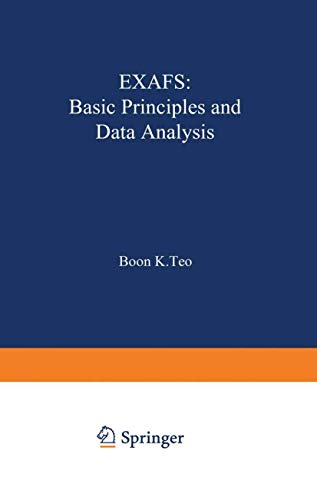Articoli correlati a Exafs: Basic Principles and Data Analysis: 9

Le informazioni nella sezione "Riassunto" possono far riferimento a edizioni diverse di questo titolo.
Le informazioni nella sezione "Su questo libro" possono far riferimento a edizioni diverse di questo titolo.
- EditoreSpringer Nature
- Data di pubblicazione2014
- ISBN 10 3642500331
- ISBN 13 9783642500336
- RilegaturaCopertina flessibile
- Numero di pagine368
Compra nuovo
Scopri di più su questo articolo
Spese di spedizione:
EUR 3,72
In U.S.A.
I migliori risultati di ricerca su AbeBooks
EXAFS : Basic Principles and Data Analysis
Descrizione libro Condizione: New. pp. xviii + 349. Codice articolo 26142285060
EXAFS: Basic Principles and Data Analysis (Inorganic Chemistry Concepts, 9)
Descrizione libro Condizione: New. Buy with confidence! Book is in new, never-used condition. Codice articolo bk3642500331xvz189zvxnew
EXAFS: Basic Principles and Data Analysis (Inorganic Chemistry Concepts, 9)
Descrizione libro Condizione: New. New! This book is in the same immaculate condition as when it was published. Codice articolo 353-3642500331-new
EXAFS : Basic Principles and Data Analysis
Print on DemandDescrizione libro Condizione: New. Print on Demand pp. xviii + 349. Codice articolo 135046875
EXAFS: Basic Principles and Data Analysis
Descrizione libro Taschenbuch. Condizione: Neu. Druck auf Anfrage Neuware - Printed after ordering - The phenomenon of Extended X-Ray Absorption Fine Structure (EXAFS) has been known for some time and was first treated theoretically by Kronig in the 1930s. Recent developments, initiated by Sayers, Stern, and Lytle in the early 1970s, have led to the recognition of the structural content of this technique. At the same time, the availability of synchrotron radiation has greatly improved both the acquisition and the quality of the EXAFS data over those obtainable from conventional X-ray sources. Such developments have established EXAFS as a powerful tool for structure studies. EXAFS has been successfully applied to a wide range of significant scientific and technological systems in many diverse fields such as inorganic chemistry, biochemistry, catalysis, material sciences, etc. It is extremely useful for systems where single-crystal diffraction techniques are not readily applicable (e.g., gas, liquid, solution, amorphous and polycrystalline solids, surfaces, polymer, etc.). Despite the fact that the EXAFS technique and applications have matured tremendously over the past decade or so, no introductory textbook exists. EXAFS: Basic Principles and Data Analysis represents my modest attempt to fill such a gap. In this book, I aim to introduce the subject matter to the novice and to help alleviate the confusion in EXAFS data analysis, which, although becoming more and more routine, is still a rather tricky endeavor and may, at times, discourage the beginners. Codice articolo 9783642500336
EXAFS: Basic Principles and Data Analysis (Inorganic Chemistry Concepts)
Descrizione libro Paperback. Condizione: Brand New. 1986 edition. 349 pages. 9.50x6.10x0.90 inches. In Stock. Codice articolo zk3642500331
EXAFS: Basic Principles and Data Analysis
Descrizione libro Taschenbuch. Condizione: Neu. This item is printed on demand - it takes 3-4 days longer - Neuware -The phenomenon of Extended X-Ray Absorption Fine Structure (EXAFS) has been known for some time and was first treated theoretically by Kronig in the 1930s. Recent developments, initiated by Sayers, Stern, and Lytle in the early 1970s, have led to the recognition of the structural content of this technique. At the same time, the availability of synchrotron radiation has greatly improved both the acquisition and the quality of the EXAFS data over those obtainable from conventional X-ray sources. Such developments have established EXAFS as a powerful tool for structure studies. EXAFS has been successfully applied to a wide range of significant scientific and technological systems in many diverse fields such as inorganic chemistry, biochemistry, catalysis, material sciences, etc. It is extremely useful for systems where single-crystal diffraction techniques are not readily applicable (e.g., gas, liquid, solution, amorphous and polycrystalline solids, surfaces, polymer, etc.). Despite the fact that the EXAFS technique and applications have matured tremendously over the past decade or so, no introductory textbook exists. EXAFS: Basic Principles and Data Analysis represents my modest attempt to fill such a gap. In this book, I aim to introduce the subject matter to the novice and to help alleviate the confusion in EXAFS data analysis, which, although becoming more and more routine, is still a rather tricky endeavor and may, at times, discourage the beginners. 368 pp. Englisch. Codice articolo 9783642500336

